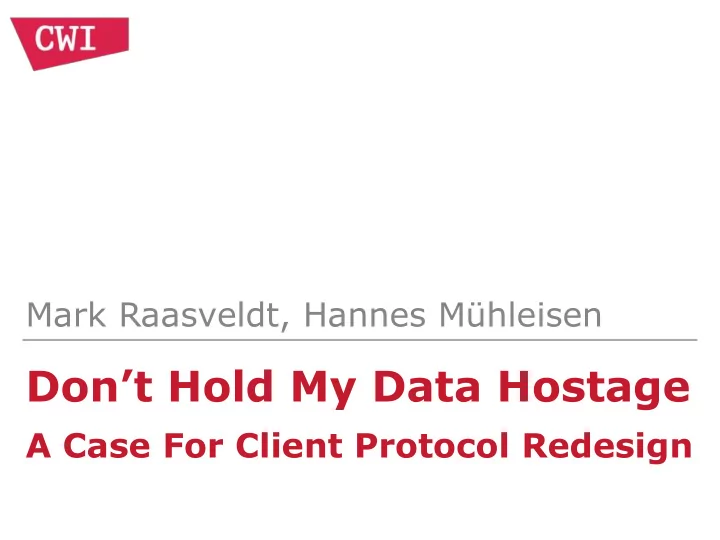

Mark Raasveldt, Hannes Mühleisen Don’t Hold My Data Hostage A Case For Client Protocol Redesign
What is a Client Protocol anyway? ▸ Every database that supports remote clients has a client protocol ▸ Using this protocol, clients can query the database ▸ In response to a query, the server computes a result ▸ Then the result is transferred back to the client
What is a Client Protocol anyway?
Motivation ▸ Traditionally, client protocols were mainly used for printing output to a console ▸ Console clients (psql, mclient) ▸ Currently, many clients actually want to use and analyze the data ▸ External analysis tools (R/Python) ▸ Visualisation tools (Tableau)
Motivation ▸ Problem: Current protocols were designed for exporting small amount of rows ▸ OLTP use cases ▸ Exporting aggregations ▸ Exporting large amounts of data using these protocols is slow
Motivation Netcat (0.23s) Operation MySQL 5.9 5.9 5.9 5.9 Connection MySQL+C 7.4 7.4 7.4 7.4 Printing Query Execution 9.8 9.8 9.8 9.8 MongoDB RSS + Transfer 11.4 11.4 11.4 11.4 PostgreSQL 12.1 12.1 12.1 12.1 DBMS X DB2 12.9 12.9 12.9 12.9 MonetDB 13.9 13.9 13.9 13.9 24.6 24.6 24.6 24.6 Hive 0 10 20 Wall clock time (s) ▸ Cost of exporting 1M rows of the lineitem table from TPC-H (120MB in CSV format) on localhost
Motivation ▸ We are not the first ones to notice this problem ▸ A lot of work on in-database processing, UDFs, etc. ▸ However, that work is database-specific and requires adapting of existing work flows ▸ This work: Why is exporting large amounts of data from a database so inefficient? ▸ Can we make it more efficient?
Cost of Data Export ▸ We don’t care about printing and connection costs ▸ What about result set (de)serialization + transfer?
Cost of Data Export ▸ Result Set Serialisation ▸ Compression, data conversions, endianness swaps, copying data into a buffer ▸ Data Transfer Time ▸ Result Set Deserialization ▸ (De)compression, data parsing, endianness swaps
State of the Art Protocols ▸ Why do these protocols exhibit this behaviour? ▸ Let’s take a look at this simple table serialised using different databases’ result set serialisation formats.
State of the Art Protocols Message Length Length Length Field 1 Field 1 Field 2 Field 2 Count Type Field Data Data 44 00 00 00 17 00 02 00000004 00 00 10 BC 00 00 00 05 4450464B47 44 00 00 00 14 00 02 00000004 05 F5 E1 00 00 00 00 02 4F4B ▸ PostgreSQL serialisation of the previous table
Protocol Implementation ▸ We implemented our own protocol ▸ In MonetDB ▸ In PostgreSQL ▸ Without per-row overhead ▸ With efficient compression techniques
Benchmark Results
Conclusion ▸ Current protocols are not suited for large result set export ▸ This leads to large result set export being a bottleneck ▸ We show there is room for improvement by implementing our own protocol that is an order of magnitude faster
Recommend
More recommend